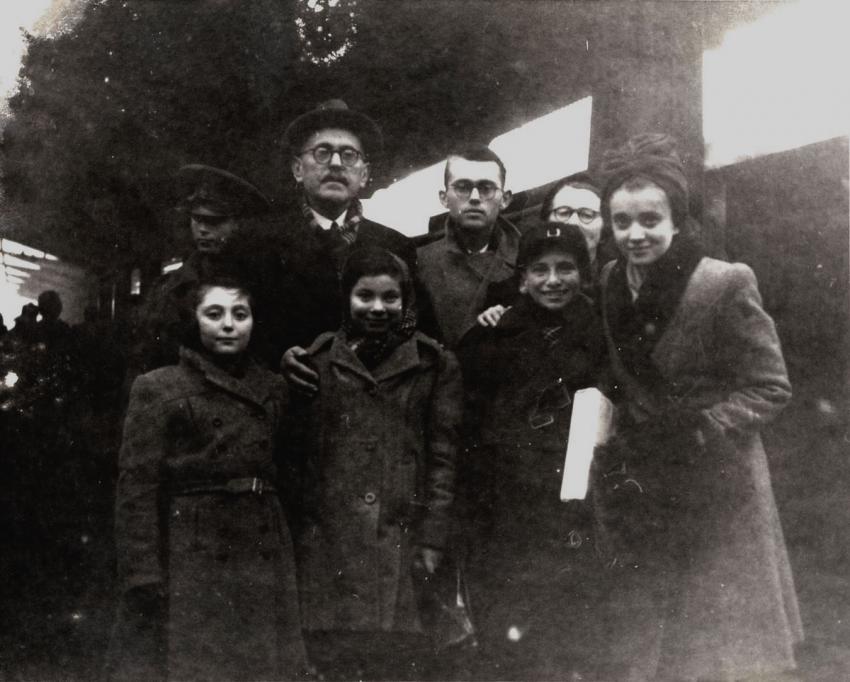In early 1943, with the German defeat at Stalingrad and the harsh losses of the Romanian army at the front, the Romanian government realized that the tide of the war was turning, and sought ways to approach the Allies and pull out of the war. This shift had major ramifications upon their policies towards the Jews. They removed many of the bureaucratic impediments in the path of Romanian Jewry that prevented them from sending help to the Jews in Transnistria. Additionally, the Jews in Romania were able to reestablish connections with the various ghettos of Transnistria. In spring 1944, thousands of Jewish survivors of the Transnistria ghettos and camps were returned to Romania, including some 2,000 children.
However, for hundreds of these children, their suffering was not yet over. This photograph, taken in December 1944 in Bucharest, depicts some of the Jewish orphans whom the Red Army moved to orphanages and to work in the coal mines of Ukraine. These same children had only returned from the ghettos in Transnistria a few months earlier.
In the summer of 1941, with the invasion of Germany and Romania into the Soviet Union, the Romanians occupied a large swathe of territory in Ukraine on the other side of the Dniester River – Transnistria – to which some 150,000 Jews were deported. Many of the Jewish deportees were murdered on the death marches to Transnistria, or perished from starvation, cold and disease due to the harsh living and working conditions in the ghettos and camps of Transnistria.
In February 1943, the Red Army defeated German forces at Stalingrad, and then defeated the Romanians in a string of battles in Ukraine. Romanian ruler Ion Antonescu presumed that alleviating the Jews' plight would cast the Romanians in a positive light in Allied eyes, which would in turn improve the conditions of surrender imposed on Romania. The Jews in Romania were thus permitted to assist Jews who had been deported to Transnistria. Jewish organizations made contact with the ghettos in Transnistria in an attempt to return the deportees, but their return was opposed by the governor of Transnistria and by the Nazis. In March 1943, a Romanian government commission voted to enable some of the deportees to return, but the decision was overturned following German pressure on Antonescu.
With the approach of the Red Army to Transnistria, the Romanians started allowing the deportees to return. In November 1943, the Romanian government allowed for the return to Romania of Jewish orphans under the age of twelve, which after deliberations was raised to 15. In February 1944, the final orders were issued, which allowed some 1900 Jewish orphans who had gathered in Mogilev-Podolsk and Tiraspol to return to Romania.
In March 1944, Transnistria was liberated by the Red Army. Orphans were returned to Romania, and with them, thousands of adult survivors. They were joined by many children and adults whose return had not been authorized. Shmuel Berkowitz recalls:
I will never forget that terrible scene, for as long as I live. Mothers approached the orphan train and threw their children inside, in order to save them. But the guards noticed, and at the border stop, they informed their superiors. Strict checks were carried out, and children without the requisite permits were immediately put on another train and returned to Mogilev. One girl… travelled from Mogilev to Iasi clinging to an axle underneath the carriage, and survived.
Berta Morgenstern relates:
When we approached the border, Dr. Sternberg counted the children again, but was suddenly shocked to find one extra child… the dilemma placed before him was, who would be saved, and who would be returned to hell. He spied a box of medicines. He looked for a small child who would be able to lie inside it for half an hour until we passed the border. I was the one who was put inside the box, on which he sat another child. When everything went according to plan, I was taken out of the box.
The "Autonomous Commission of Assistance", active in Budapest, handled the absorption of Jewish orphans who returned from Transnistria in the spring of 1944. The orphans were brought to Iasi and placed with Jewish families.
In August 1944, Antonescu's fascist regime was overthrown, and Romania surrendered to the Allies. Legislation passed in September and December stipulated that anti-Jewish laws must be revoked, and that Jews were entitled to reclaim the property that had been appropriated. However, when the Jews returned home, they discovered that most of their property had been looted, their houses were inhabited by strangers, and the neighbors were hostile.
Bessarabia and Northern Bukovina had been under Soviet rule since June 1940, and were now annexed to the Soviet Union. The Soviets claimed that orphans originally from Bessarabia and Northern Bukovina should be returned to Soviet territory. Thanks to the intervention of the Bucharest Jewish community, some of the orphans were allowed to remain, but 520 were handed over to the Soviets.
Jews who had survived the ghettos and camps of Transnistria were drafted to the Red Army, including orphans aged 13 and up. Some were taken for forced labor in Soviet labor camps deep in the Soviet Union.
Of the 150,000 Jews deported to Transnistria, approximately 50,000 survived. Most of the Jews living in Romania after the war immigrated to Israel in the early 1950s.
Yad Vashem Photo Archives 100DO6







